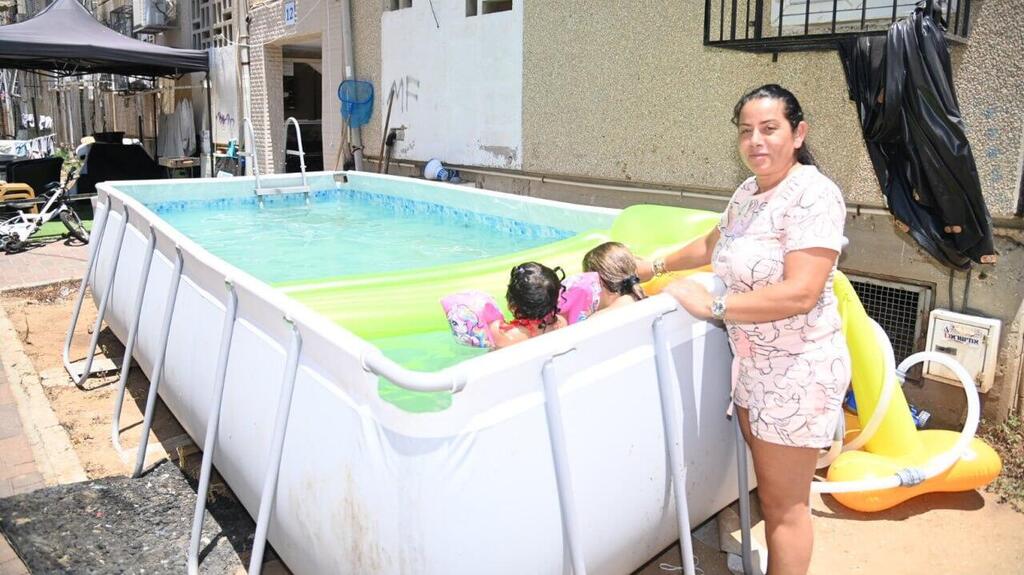Our Terms & Conditions | Our Privacy Policy
Energy poverty exacerbates summer heat for Israel’s vulnerable communities
As summer heat intensifies, Tami Alkobi and her five children in Or Yehuda spend as little time as possible in their sweltering apartment, where broken shutters and a kitchen window net allow temperatures to soar.
“When school’s in session, the kids are there during the day, but during the break, it’s a problem. At night, they wake up from the heat—it’s like living in a tent,” Alkobi said. Their air conditioner runs overtime due to poor insulation, driving up electricity costs.
3 View gallery

Tami Alkobi with her children at an improvised pool near their home
(Photo: Yair Sagi)
To cope, they rely on a donated inflatable pool and extended hours at the public pool, thanks to passes from the local welfare department. “We spend most of the day in the pool below the apartment or at the public one—it’s better than being inside,” she added.
The scorching heat wave gripping Israel disproportionately impacts residents of older, poorly insulated homes, particularly those who cannot afford cooling solutions. A., a resident of Be’er Sheva, lives in an Amidar public housing unit with her three children, one with special needs.
“We’re stuck at home in unbearable heat; it’s hard to breathe,” said A., who is unable to afford air conditioning or even a fan. With record-breaking temperatures expected all this week and climate change set to worsen conditions, the issue of energy poverty—where households cannot meet basic energy needs like lighting, charging devices or cooling—demands urgent attention.
The Welfare Ministry defines energy poverty by three factors: inability to access sufficient energy for basic needs, unequal access to affordable and efficient energy sources and living in homes with low energy efficiency.
According to the Knesset Research and Information Center, in 2021, about 368,000 households—13% of Israel’s total—spent over 10% of their income on energy, though the ministry suggests the actual number is higher.
3 View gallery


Broken shutters allow the hot air to come inside
(Photo: Yair Sagi)
Poorer households allocate a disproportionate share of their income to electricity, with the lowest income decile spending over a tenth of their earnings on power, compared to a fraction for the wealthiest. Cooling homes is no luxury but a necessity, as highlighted in a report by the Heschel Center for Sustainability, which warns that high temperatures pose serious risks to physical and mental health.
Danny Gigi, chair of the Public Housing Forum, emphasized the dire situation in older public housing units with outdated electrical infrastructure. “When Amidar renovates, they don’t upgrade to three-phase electricity—it’s absurd,” Gigi said.
He argued the state could invest in insulation, energy efficiency and mandatory solar panels for Amidar properties to reduce costs for tenants, but such measures remain limited.
A carbon tax approved last year increased energy costs, with 700 million shekels ($190 million) of its revenue allocated over six years for welfare initiatives. Avivit Halinzon, a social worker overseeing energy poverty programs at the Welfare Ministry, said these funds will support training for social workers and vulnerable communities to raise awareness.
“We’re not used to checking electricity meters, broken windows or appliance efficiency,” Halinzon noted. “The goal is to teach simple actions—like fixing windows or replacing appliances—to better cope with extreme weather.” Some funds will also aid in purchasing energy-efficient appliances.
The Energy Ministry recently launched a 4 million shekel ($1.1 million) program to help local authorities address heat and cold waves for low-income households, encouraging social services to assess energy needs and replace inefficient appliances. A 2010 energy efficiency program, costing 628 million shekels ($170 million), yielded a 1.3 billion shekel ($350 million) return by upgrading household appliances.
Under the new initiative, local authorities with viable plans can receive up to 80% project funding. The ministry acknowledged this is insufficient to fully tackle energy poverty but hopes it will spur further action by local governments and stakeholders.
Images are for reference only.Images and contents gathered automatic from google or 3rd party sources.All rights on the images and contents are with their legal original owners.



Comments are closed.